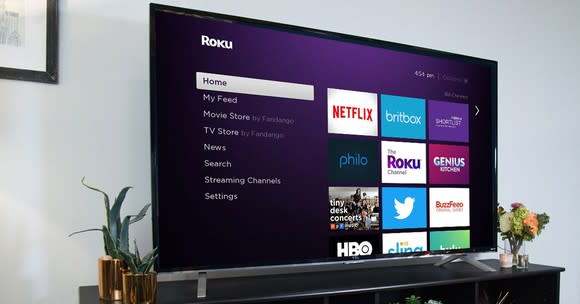Roku's 3 Main Areas of Growth
Roku (NASDAQ: ROKU) is no longer just a set-top box business.
Last quarter, the company's platform revenue surpassed sales from its streaming players. Platform revenue is made up of advertising and distribution revenue (affiliate fees for helping sell subscription services). Those services ought to continue growing for years to come, but understanding where exactly the growth is coming from is key to understanding Roku's potential.
Roku's CEO Anthony Wood sat down with an analyst at Needham's Emerging Technology conference last month to discuss the company's main areas of growth. Here's a breakdown of three main areas of Roku's growth touched on in the conversation.

Image source: Roku.
Video advertising
Perhaps the biggest source of growth will come from video advertising. Roku expects to attract a significant chunk of the $70 billion in U.S. television ad spend.
In its first-quarter letter to shareholders, management highlighted a survey that found "10% of all adults between 18 and 34 can only be reached on TV on the Roku platform in the living room." As that number grows, television advertisers hoping to reach the audience they're used to on the medium they're used to will have to increase their spending on Roku.
Roku's video advertising inventory is supported by hundreds of ad-supported streaming apps available in the Roku Channel Store. If Roku signs up a new user for one of those apps, it's generally rewarded with a share of the ad inventory.
Last year, Roku launched the Roku Channel, which aggregates content from dozens of partners and includes some content Roku licenses itself. Roku controls the ad inventory in the Roku Channel, and it shares revenue with content partners. The Roku Channel also allows Roku to gain greater insight into its users' watch habits, enabling a better ad experience. As such, Roku is expanding the Roku Channel beyond its own devices.
Display advertising
Roku's original ad product is display ads shown on its home screen and when its devices are sleeping. These ads are generally endemic in nature, advertising a streaming service or certain content you can watch on your Roku device.
As more and more media companies start offering over-the-top options, Roku should see an increased demand for its display advertising as well. Roku has the largest audience of video streaming customers with nearly 21 million active accounts. That makes its home screen prime real estate for streaming apps.
Importantly, competitors like Apple and Amazon don't have the same audience-building display advertisement products that Roku has. If Disney (NYSE: DIS) or CBS (NYSE: CBS) wants to build an audience for its new streaming apps, Roku is one of the best places to do so.
Both Disney and CBS have massive advertising budgets, and they're betting big on streaming. CBS launched All Access in 2014 and brought the service to Roku in 2015. It's since launched streaming services for its news and sports programming as well. Disney is following a similar path, recently launching ESPN+ with plans to launch a Disney-branded service next year. Disney, notably, made ESPN+ available on Roku the same day as its launch.
Both Disney and CBS have a lot riding on their streaming services as they work to offset cord-cutting and use the services as leverage in negotiations with cable distributors. As more big media companies follow their lead, Roku's display advertising business ought to see a boost from their big ad budgets.
Distribution revenue
Distribution revenue will follow the same narrative as the growth in Roku's display advertising. Roku receives a cut from every new subscriber it signs up for premium video subscription services like ESPN+ or CBS All Access.
What potentially makes distribution even more valuable than its advertising is that Roku receives a percentage of revenue every month from the service throughout the lifetime of the customer it signs up. So, instead of a one-time sale for someone checking out an app based on an ad, Roku gets paid over and over again.
As more premium subscription services enter the market, from stand-alone streaming services from media companies to entire premium live-TV services, Roku has more opportunities to sign up customers for more services.
Distribution revenue may also benefit from the growing trend of cord-cutting, which could lead some consumers to spend more on subscription streaming services. If consumers are willing to pay more for streaming since they're not spending money on cable, Roku will be a direct beneficiary.
While Roku is best known for its streaming devices, investors need to understand that business isn't a growth business anymore. Roku's growth will come from video ads, display ads, and distribution agreements with streaming partners, and all three businesses look poised for lots of growth.
More From The Motley Fool
John Mackey, CEO of Whole Foods Market, an Amazon subsidiary, is a member of The Motley Fool's board of directors. Adam Levy owns shares of Amazon and Apple. The Motley Fool owns shares of and recommends Amazon, Apple, and Walt Disney. The Motley Fool has the following options: long January 2020 $150 calls on Apple and short January 2020 $155 calls on Apple. The Motley Fool has a disclosure policy.
